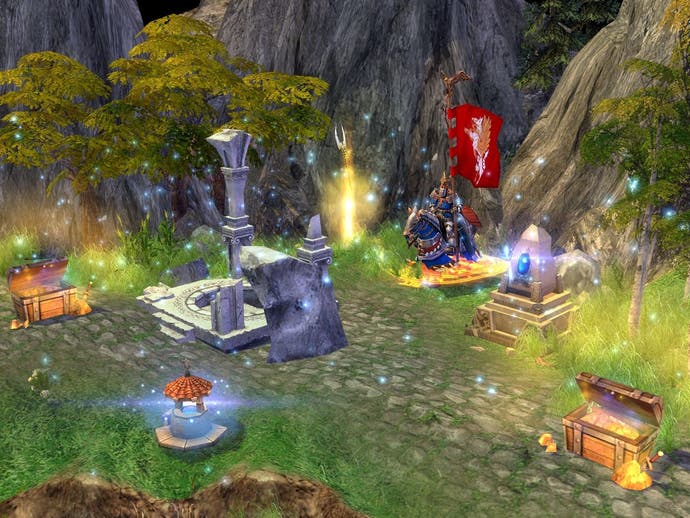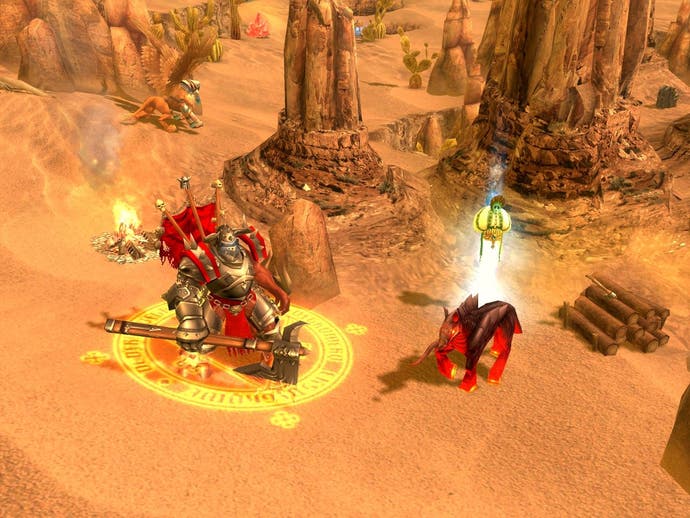Heroes of Might & Magic V
No more heroes any more.
There's something cosy about the Might & Magic series. Something a bit tea and cakes on Granny's knee; all warm fireplaces and chintzy doilies. Something conservative, something that flies the Union Jack, something that reminds us of a much better past, something warm and something very, very familiar. Perhaps it's the fact that in the twenty years since the series started, it's changed about as much as David Dimbleby or Horlicks, even if everything else from the era is gone.
As we explained in our numerous previews, HOMM:V (an acronym sounding nearer to a corpulent Yankee car than a game) is striving to stick to the formula at all costs. We can finally reveal that... yes, they've done it. They've made another turn-based M&M strategy game and it's a good example of the series. However, does that mean the series bears up to scrutiny in the modern day?
Our sagging eyelids wish to testify in the affirmative; HOMM has lost none of its predecessors' addictiveness. The six factions (Knights, Demons, Undead, Wizards, Elves and Dungeon) are all distinctive enough, though packed with familiar units, heroes and designs from the earlier games. They're all introduced in a logical manner, with the knight (Haven) campaign acting as a (very lengthy) tutorial and the other campaigns gradually introducing the various heroes and units you need to get to grips with to master each race (and, yes, you can alter the difficulty level, if you're having trouble). The overarching plot may be tortuous, the voice-acting sounds like our aforementioned granny was directing it, and the interminable (skippable, thanks be) cut-scenes are about as stimulating as a modern dance interpretation of the Hutton report (no worse than WarCraft III's, in other words), but it's all just grist to the mill of getting into the complicated world beneath.

You start with a hero (doesn't every story?). These can move so far every day (the days being yours and the enemy's alternated turns), and there are so many days in a week (the week being the period it takes for new troops to be available). Your hero and his/her associated army can capture buildings, collect resources, battle enemy armies (and AI creeps) and capture cities. As they do all this, they gain experience allowing them to garner new abilities (over 200 new ones are in the game) which alter the way they do everything. You can control them purely with your mouse, though there's a wealth of keyboard shortcuts if that's your bag.
Once you've got your city (there are only a few of these in any map), you can proceed to upgrade it. It's here that we'd better pause and say just how damn lovely this game can look (outside of the low-poly battle scenes). "This game looks damn lovely." "(Outside of the low-poly battles scenes.)" The cities really show off the game's engine, especially as you build more bastions, buttresses, follies and oubliettes all over them. It's sad then that you can't admire them in more detail, rotating the city or zooming in, and that your interaction with them is so limited - you'll be spending much more time on the (now 3D and rotatable!!!) world maps. (It's also sad that the music and sound effects are a bit clunky). As you build more buildings at the city, they produce more resources, troops and heroes, let you trade any of the many resources for any other, teach your heroes spells and even spy on your enemy. Each improvement upgrades visually on the city screen so you end up with a massive fortress, whether it's floating in the sky, a flaming pile of obsidian, or a traditional citadel, you can really be proud of it.
When your hero plunges into combat with an AI creep (guarding some resources or magic items) or an enemy army, the game switches to a familiar grid-based. It mostly works okay, but there are a few major flaws. First, the enemy's tactic appears to be restricted to targeting your strongest units, meaning strong flying creatures can be used as endless distractions. The occasional foliage and obstacles on the battlefield also add little challenge, and change the tactical layout very little. Second, it's hard to defend your always-targeted missile units without a large number of encircling units, due to diagonal attacks and movement, making small skirmishes hardly worth fighting.

Playing with larger armies is much better, and closer to the Magic the Gathering/Etherlords tradition that Nival are familiar with. We have to admit, we set the battles to run on "quick combat" after the first campaign, only choosing to fight difficult battles ourselves. Like Rome: Total War, it would have been welcome to have the option to auto-resolve or to fight the battle yourself offered before each one, rather than having to resort to the settings menu in times of danger. However, other than that (and the horror of losing your hero and all your troops if you lose) it's fine...
So. Cities support heroes and armies, who support cities. It's a great big chain of reactions you'll need to manipulate carefully to conquer enemy armies. To do this, us committed strategy geeks need spreadsheets, a central Civilopedia and map filters available, so we know what the hell we're doing, so it's a pity that this is only communicated through slowly-expanding tooltips - helpful, but not great. Despite the lack of information the game offers it's a pleasant challenge to fight. Once you're bored with the single-player, you can then move onto the superior skirmish mode and hotseat multiplayer.
We've also had a chance to play the skirmish and multiplayer modes now, and we're rather happy. Admittedly the turn-based gameplay is predictably slow and it's hard to tell how balanced the game is (because of the enormous variety of heroes and units), but it seems solid enough. We have problems with some of the elements of hot-seat multiplayer - the lack of a proper fog of war for example - and the lack of a map editor is scandalous (meaning players will have to rely on Ubisoft's generosity for new maps and continue using the limited selection of predominantly free-for-all maps that ship with the game - already there's talk of user-created editors), but overall the multiplayer seems to work.
HOMMV was the best-selling UK PC game in the week of its release; admittedly, it was up against some pitiful competition (it was only 33rd in the multiformat chart) but its refreshing length and variety of campaign, and depth of gameplay make you understand why it deserved even that paltry accolade. It's not a great leap forward for gaming; but in terms of reassurance and welcome traditionalism, it's a small step for cosiness.

